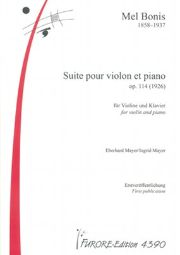Creator against all odds
Mel Bonis used rural impressions in her Suite for violin and piano. Her entire, extensive oeuvre is worth rediscovering.

Mélanie Bonis' piano improvisations were considered a nuisance by her petty-bourgeois Parisian parents, but - encouraged by César Franck - she was allowed to attend the Conservatoire Supérieur, but had to abandon her successful studies before the end because her parents did not approve of her love affair with fellow student Amédée Hettich. Married to the rich widower Albert Domange, 25 years her senior, with five sons, to whom she gave another four children, she had little time for music. Nevertheless, she was able to publish several works under the pseudonym Mel Bonis (women composers were not taken seriously at the time; she had to finance some editions herself) with Leduc and Eschig. Towards the turn of the century, Hettich encouraged her to return to intensive, even prize-winning music-making (she even became secretary of the Société des Compositeurs). She was able to keep their daughter a secret until 1914. During the First World War, she became involved in helping orphans and prisoners of war. Despite depression, she continued to compose tirelessly until the end of her life. Her 300 works for piano, organ, chamber ensemble, voice and orchestra are on a par with Fauré and Chausson, but were unjustly forgotten.
For the three-movement Suite from 1926, the manuscript of which was found in the family archive, the composer was inspired by her life in the country: I Jour de fête surprises with sparkling, syncopated upbeat motifs in which the two instruments follow each other. A more vocal intermezzo is concluded by a gallop. II Sous la ramée is an extended reverie, floating confidently between the keys. III Cortège champêtre returns to the C major of I with many imaginative modulations, reminiscent of a light-footed parade of majorettes. Musically demanding, this suite gives the performers much pleasure.
Mel Bonis, Suite pour violon et piano op. 114, edited by Eberhard Mayer and Ingrid Mayer, first publication, fue 4390, € 22.00, Furore-Edition, Kassel 2012








